While traveling in the Kumaon Himalayas, you come across this cluster of temples known as Jageshwar Dham. Nestled in the picturesque Kumaon region of Uttarakhand,it is a place of immense religious significance.
It is believed to be the abode of Lord Shiva, also known as Jageshwar or Nagesh. This temple town is surrounded by tall deodar trees and is a sight to behold with its 125 ancient stone temples.In this post, we embark on a journey to explore the rich history, legends, and architectural marvels of Jageshwar Dham.
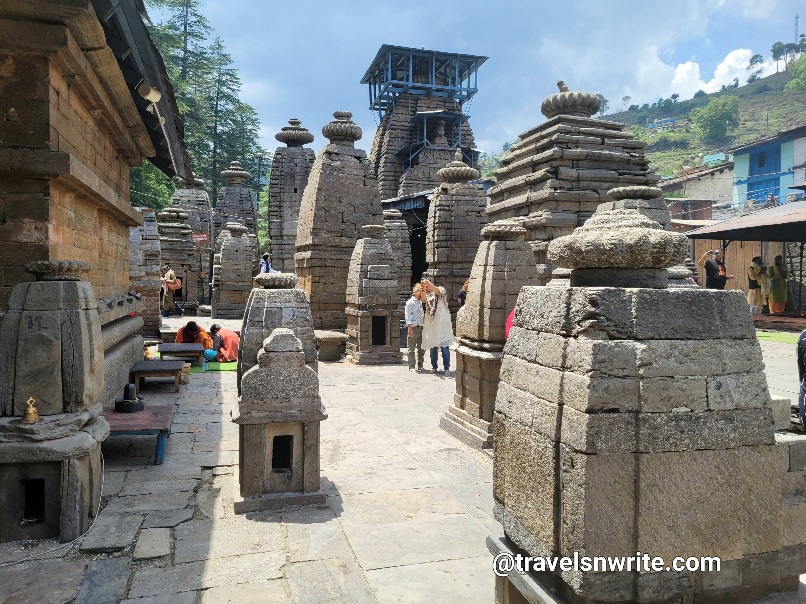
Post Contents
A Glimpse of Jageshwar Dham
As you approach Jageshwar Dham from Almora, a short drive of 35 km through the enchanting pine and deodar forests leads you to this sacred town. The valley, wrapped in a blanket of dark green, welcomes you with a sense of tranquility. As you enter the town, you are greeted by a small group of stone temples standing across a serene stream. The main temple complex, called Jageshwar Dham, is surrounded by a thick cover of deodar trees, creating a peaceful and spiritual atmosphere.
History and Legends of Jageshwar Dham
The origins of Jageshwar Dham are shrouded in mystery. The site has witnessed the rise and fall of different dynasties, leaving behind a treasure trove of architectural marvels. Most of the temples in Jageshwar Dham were built by the Katyuri dynasty, which ruled the region from the 7th to the 14th century.
The Chand rulers, who reigned from the 15th to the 18th century, played a significant role in maintaining and preserving these temples. The inscriptions found in the temples also mention the Malla Kings. However the remote location of the temple complex has failed to draw attention of Scholars and Academicians.
According to legends, Jageshwar Dham holds a special place in Hindu mythology. It is believed that after destroying Daksh Prajapati, Lord Shiva sat in meditation at this very spot. The sages’ wives, attracted to his divine presence, caused an uproar among the sages. In response, Lord Shiva cut off his phallus, leading to darkness on Earth. To restore light, the sages installed the Linga as a representation of Lord Shiva. This marked the beginning of the tradition of Linga worship.
Another legend states that Luv and Kush, the sons of Lord Ram, performed a grand Yagna in Jageshwar Dham. They invited various deities for the ceremony, making it a significant pilgrimage site for devotees of Lord Ram.
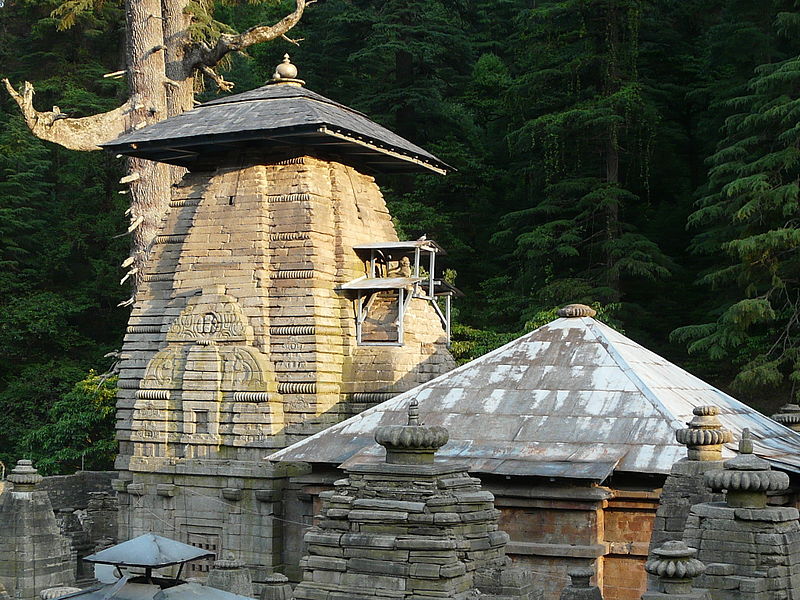
The Magnificent Temples of Jageshwar Dham
The Jageshwar Temple complex is a sight to behold, with its 124 temples dedicated to Lord Shiva in the form of Lingas. Each temple has a unique name, often derived from the panel on top of its entrance. The temples showcase various forms of Lord Shiva and other celestial beings. Let’s explore some of the prominent temples within the Jageshwar Dham complex.
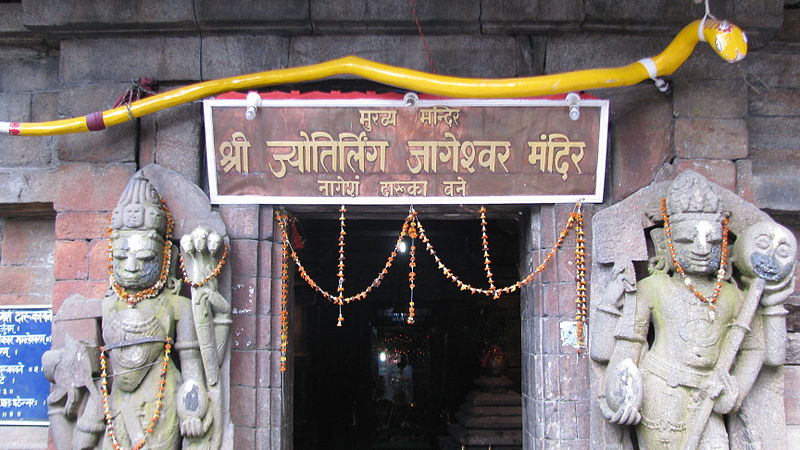
Related Post; Top Places to Visit and Things to Do in Nainital: A Vacation Guide
Jageshwar Temple – The 8th Jyotirlinga or Nagesh Jyotirlinga
The Jageshwar Temple, also known as the Nagesh Jyotirlinga, is one of the most significant temples in the complex. It is believed to be the 8th Jyotirlinga, a sacred representation of Lord Shiva. The temple is located at one end of the complex, facing the west direction. As you enter the temple, you will be welcomed by two life-size idols of Dwarpalas, Nandi and Skandi.
Inside the temple, a Mandapa leads to the Garbhagriha or sanctum sanctorum, where you can witness the majestic Shivalinga. The Shivalinga is said to be Swayambhu, emerging on its own from the womb of the earth. It is believed to have an active water source passing beneath it, creating bubbles that add to the sanctity of the place. The temple is also known as Tarun Jageshwar and Bal Jageshwar.
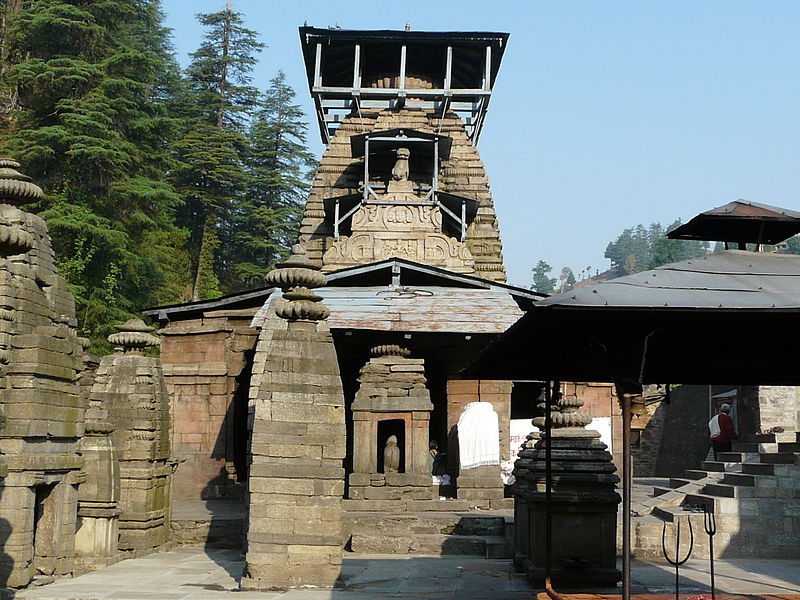
Mahamrityunjay Mahadev Temple
The Mahamrityunjay Mahadev Temple is the oldest and largest temple in the Jageshwar Dham complex. It is located in the center of the complex and dedicated to Lord Shiva in his Mahamrityunjay form, the conqueror of death. The temple boasts of a unique architecture, with a tiered tower in the curvilinear Nagara style.
Inside the temple, you can find a large Shivalinga, along with intricate carvings and inscriptions dating back to the 7th to 10th century. The temple is considered a symbol of protection and is believed to bring blessings and liberation to devotees.
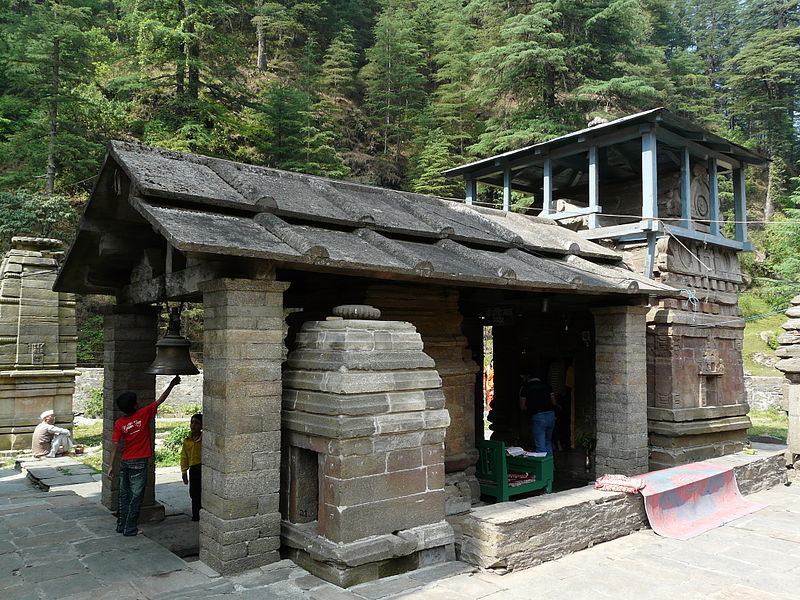
Pushti Devi Temple
The Pushti Devi Temple is another notable temple within the Jageshwar Dham complex. It is dedicated to the goddess Devi and enshrines her full murti. The temple is known for its serene ambiance and is a place of devotion and worship for devotees.The shrine of Pushti Devi which literally means nourishment is dedicated to Pushti Devi, the goddess who nourishes or gives us what we need.
Vriddh Jageshwar Temple
This temple about 3 km uphill Jageshwar, called the Old Shiva, is said to be the abode of Shiva before he came down to Jageshwar. The unremitting peace they emanate is one of the most fascinating aspect about both Jageshwar and Vridh Jageshwar
Other Temples in Jageshwar Dham
Apart from the main temples, there are numerous other temples within the complex, each with its own unique architecture and significance. Some of these temples include the Dakshinukhi Hanuman Temple, Nav Griha Temple dedicated to the nine planets, Kedareshwar Temple with irregular rock-shaped Shivalingas, Lakulisha Temple depicting the 28th avatar of Lord Shiva, Tandeshwar Temple with a panel depicting dancing Shiva, and Batuk Bhairav Temple, among others. Each temple tells a story and adds to the spiritual aura of Jageshwar Dham.
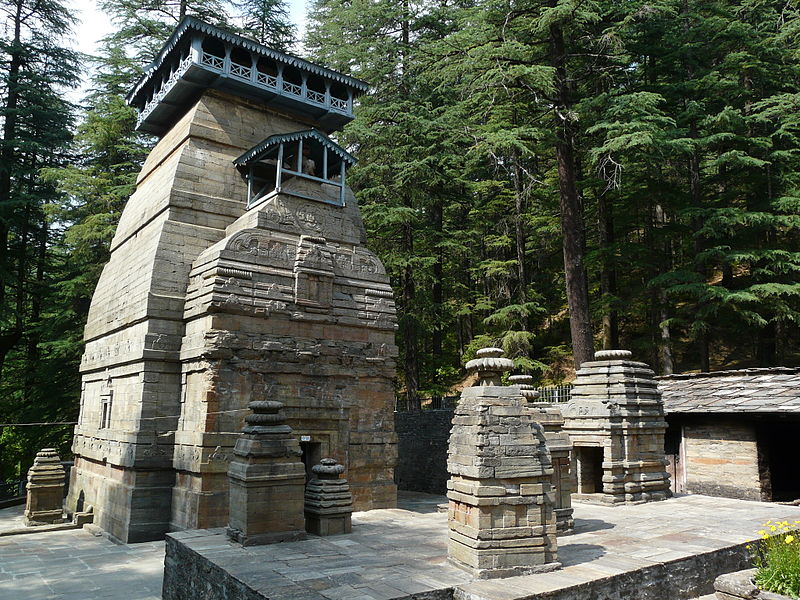
Do Read: Places to Visit & Things to Do in Mukteshwar – Your Ultimate Guide
Dhandeshwar Temple Complex
As you proceed towards Jageshwar Dham from Almora, just 2 kms ahead of the main temple complex, you are at Dandeshwar Group of temples situated in a picturesque location next to Jat Ganga River.. The Temple Complex consists of one large temple and 14 subsidiary shrines. Most of the shrines are situated around the major temple and few were scattered around the temple complex.
This large temple is considered as one of the tallest temples in the Kumaon region. Lord Shiva housed in the sanctum is in the form of rock not as traditional Linga suggesting an acceptance and proliferation of artist diversity. Its tower consists of stacked series of amalaka in the form of cogged discs of shrinking diameter.
Below is the square sanctum (Garbha griha) whose door frame and mandapa are formed by square pillars. Inside the sanctum is a Chaturmukha Shiva Linga, each face looking in a cardinal direction..
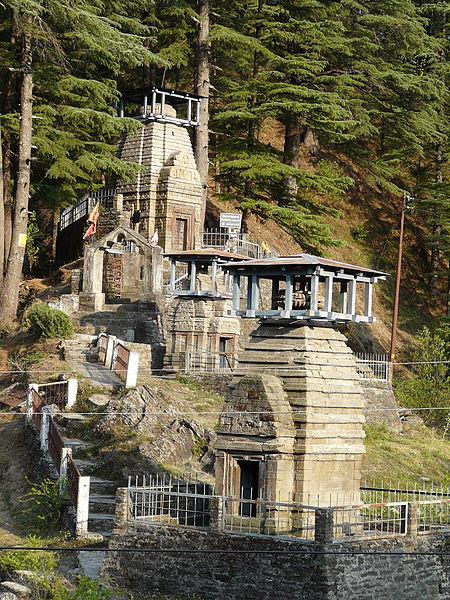
Kubera Temple Complex
This is another group of temples that dot the landscape of Jageshwar Dham. Kuber Temple Complex consists of three temples on the right bank of the Jat Ganga River, on the hillock opposite the main Jageshwar Temple Complex.The Sanctum houses an Ekamukha Shiva Lingam. The complex provides a spectacular view of the main temple complex below.
The image of the presiding deity is carved above the doorframe of the entrance door of temples in Jageshwar Temple Complex but in the Kuber temple, the image of the Kubera has been carved above the doorframe of the entrance door. There is a small Chandika temple next to the Kubera temple. This Temple houses a Shivalinga in its sanctum.This temple follows Gajapristhakriti style.
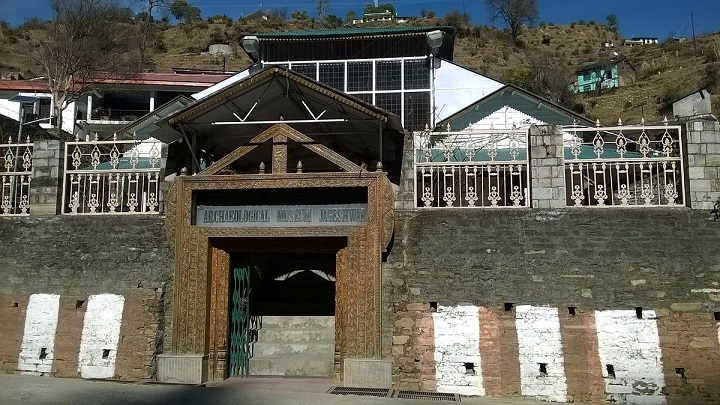
Also Read: 5 top places to visit near Badrinath
Archaeological Museum – A Glimpse into the Past
To get a deeper understanding of the rich history and artistry of Jageshwar Dham, a visit to the Archaeological Museum is a must. Located within the temple complex, this well-maintained museum showcases a collection of local sculptures and artifacts. You can witness stone images of deities like Lord Ganesha, Uma Maheshwar, and Vishnu, along with inscriptions and beautifully carved panels.
The sculpture shed constructed in the year 1995 at Jegeshwar was converted into a museum in 2000. It houses 174 sculptures, found in the region from the temples of the Jageshwar group, Dandeshwar group and Kuber group of temples, and are dated from 9th to 13th century AD.
Museum has two galleries displaying the exhibits. In the first gallery are 36 sculptures kept in two wall show cases and wooden pedestals. The masterpieces of the gallery are Uma-Maheshwar, Surya and Navgrahas. The image of Uma-Maheshwar having flying celestials, fully ornamented Parvati is sitting on the lap of Shiva. The beautiful sculpture of Surya holding a lotus in both hands is fully ornamented. Arun (the charioteer) and seven horses are shown at lower side and the rare sculpture of Navgrahas having Surya, Soma, Mangala, Budha, Brrhaspati, Shukra, Shani, Rahu and Ketu are in standing posture.
In the second gallery are 18 sculpture exhibited on the wooden pedestals. This gallery is having unique examples of Uttaranchal art as the Vishapaharanamurti (Shiva drinking poison) of Shiva, Kevalamurti and four armed Chamunda with emaciated body, shrunken belly, protruding ribs and veins, sunken eyes and holding munda in her left hand are the faithful representations of the art of this region.
The museum also houses a rare life-size image of Paun Raja, made of an alloy of eight metals. While photography is not allowed in the museum, the artifacts provide a glimpse into the artistic mastery of ancient times.
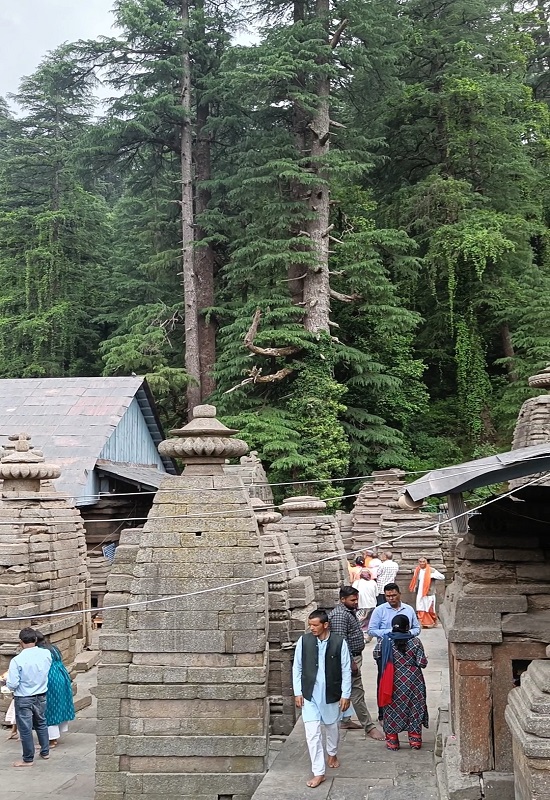
Festivals and Celebrations
Jageshwar Dham is known for its vibrant 0pfestivals and celebrations. The two main festivals celebrated here are Shivratri and Shravan Maas. Shivratri, the night of Lord Shiva, is celebrated with great enthusiasm, attracting devotees from far and wide.
It is believed that Lord Shiva performed his divine dance, the Tandav, on this auspicious night. Shravan Maas, also known as the month of Saavan, is another significant festival. Devotees offer prayers and seek blessings during this holy month, which usually falls between July and August. The temples of Jageshwar Dham come alive with music, chants, and a vibrant atmosphere during these festivals.
The Spiritual Experience of Jageshwar Dham
A visit to Jageshwar Dham is not just a pilgrimage but a spiritual experience. The serene surroundings, the ancient temples, and the divine aura make it a place of immense peace and devotion. As you explore the temple complex and witness the architectural marvels, you can’t help but be in awe of the craftsmanship and dedication that went into their creation. The chants, prayers, and rituals performed by the devotees create a sense of unity and spiritual energy.
How to Reach Jageshwar Dham
Jageshwar Dham is located approximately 36 kilometers northeast of Almora in the Kumaon region of Uttarakhand. The nearest railhead is Kathgodam, which is around 125 kilometers away. From there, state transport buses and private taxis are available to reach Jageshwar. The town is well-connected by road to Almora, Haldwani, Pithoragarh, and other nearby towns.
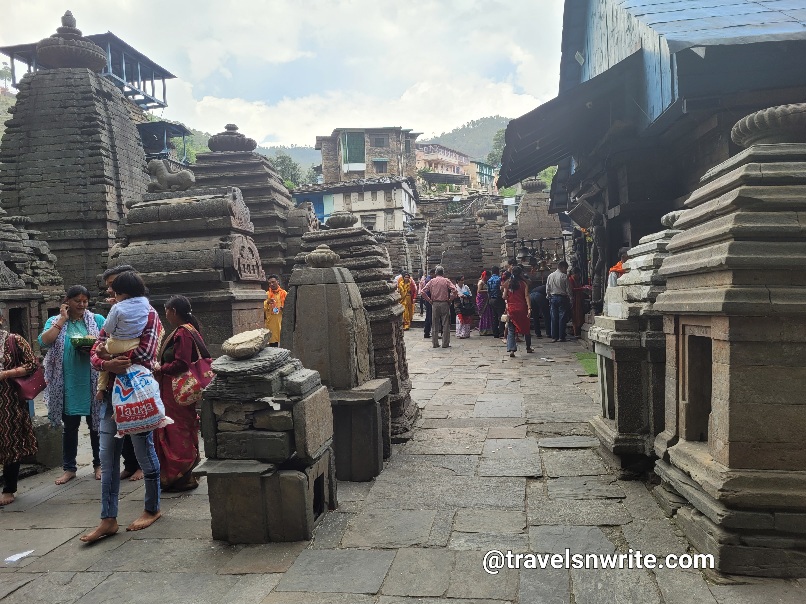
Must Read: How to plan your Badrinath Trip-A complete guide
Plan Your Visit to Jageshwar Dham
If you are planning a visit to Jageshwar Dham, it is advisable to plan your trip during the monsoon festival of Jageshwar or the Maha Shivratri Mela. These festive times offer a unique opportunity to witness the vibrant atmosphere and the devotion of the pilgrims. However, irrespective of the time of visit, Jageshwar Dham promises a serene and spiritually uplifting experience.
Jageshwar Dham, with its ancient temples, rich history, and breathtaking natural beauty, is a place that will leave an indelible mark on your soul. Whether you are a devotee seeking spiritual solace or a history enthusiast marveling at the architectural wonders,
Jageshwar Dham offers a journey of discovery and enlightenment. So, embark on this divine pilgrimage and immerse yourself in the sacredness of Jageshwar Dham, the abode of Lord Shiva in the enchanting Kumaon region of Uttarakhand.
Frequently Asked Questions (FAQs)
Jageshwar is nestled at an altitude of 1870 meters above sea level, offering a serene and tranquil atmosphere for spiritual seekers
Jageshwar offers a range of accommodation options, ranging from budget to moderate hotels. However, for a wider selection, you can also consider staying in Almora, where hotels and resorts of various budgets, including luxury and 1-star properties, are available.
Jageshwar can be visited throughout the year due to its temperate climate. Summers are cool and pleasant, while winters are cold with occasional snowfall. The best time to visit is during the months of April to June and September to November when the weather is most favorable for sightseeing.
Finding an ATM or a petrol pump in Jageshwar can be challenging. It is advisable to ensure that you have taken care of these requirements in Almora before proceeding to Jageshwar.
Yes, it is possible to visit Patal Bhubaneswar from Binsar via Jageshwar. This route allows you to explore multiple spiritual destinations in Uttarakhand. Plan your itinerary accordingly and ensure that you have sufficient time to devote to each place of interest.

